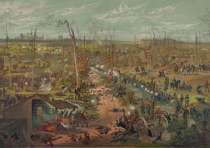
Established in 1894 to preserve the scene of the first major battle in the Western theater of the Civil War, the site also commemorates the siege, battle and occupation of the Corinth railroad junction.
The Union army steadily gained control of Tennessee in 1862, capturing Fort Henry and Fort Donelson as well as Nashville. The Confederacy, struggling for life, decided to concentrate their forces at Corinth, Mississippi, a major railroad junction that could also give the North access to Memphis and open up several hundred miles of the Mississippi River if they managed to take the town. The effort to protect Corinth culminated in the battle of Shiloh, named for the Shiloh Methodist Church, located near the Union encampment. The Confederate commander, Gen. Albert Sidney Johnston, marshaled about 44,000 troops for his Army of Mississippi; General P. G. T. Beauregard was second-in-command.
A Confederate victory seemed likely, as they had the element of surprise, and the Federal encampments lacked tactical formation. Nevertheless, the Southern attack did not develop as Johnston originally planned. An inefficient attack formation and confusion slowed the assault. In mid-afternoon, Johnston sustained a leg wound and bled to death shortly thereafter. Perhaps most importantly, a natural defensive position, "the Hornets' Nest," as it was dubbed by the Southerners, became a rallying point for Federal troops. The action at the Hornets' Nest focused the Confederates’ attention away from an opportunity to break through the weaker Union left nearer the river.
Buell arrived with reinforcements during the night, and Lew Wallace came up from Crump's Landing to take a position on the right side of the Union line. In all, the Federals mustered an additional 25,000 men on April 7. They drove the Southerners back across the battlefield and forced them to retreat to Corinth.
The two-day carnage approached 24,000 casualties; each side counted more than 1,700 dead and 8,000 wounded in addition to the missing. With casualties totaling nearly five times those of First Bull Run, Shiloh became the bloodiest battle of the war up to that time.
Tools
Key Facts
- April 1862 battle was the bloodiest battle of the war up to that time.
- Union troops drove the Southerners back across the battlefield and forced them to retreat to Corinth.




